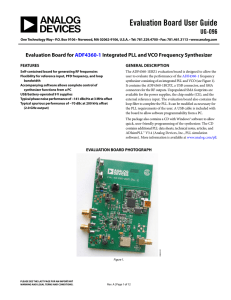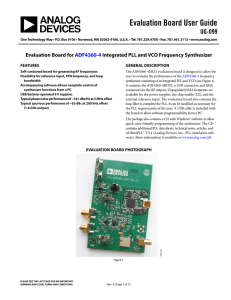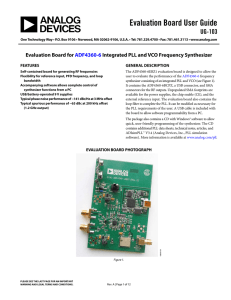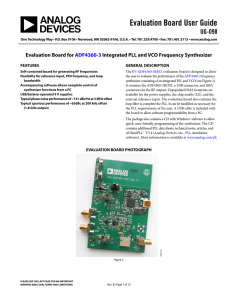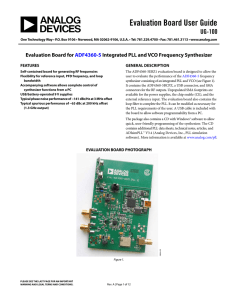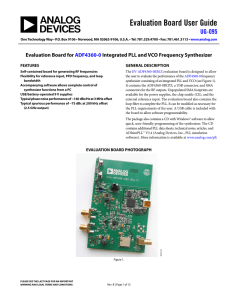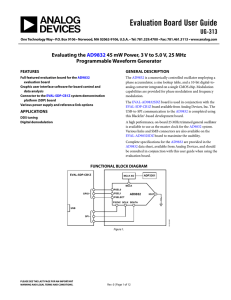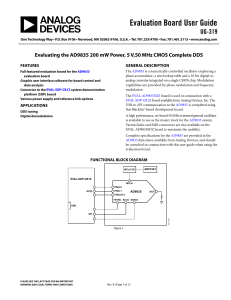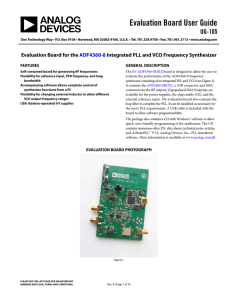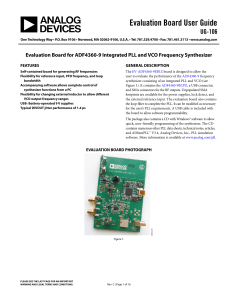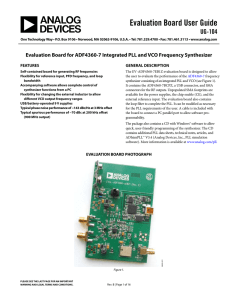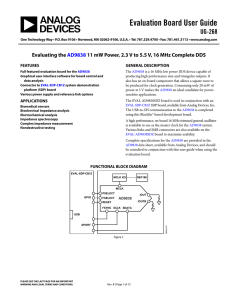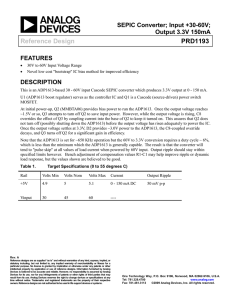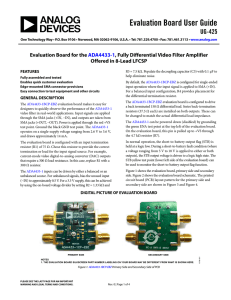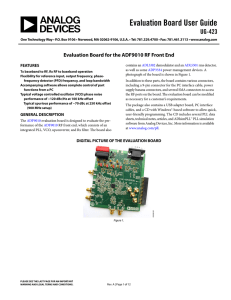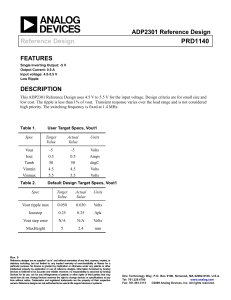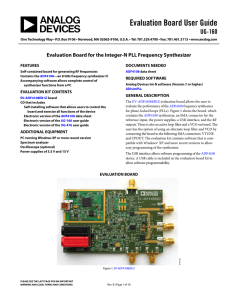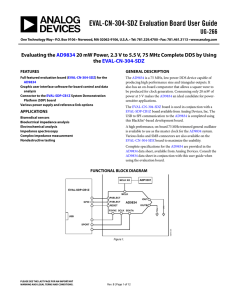Evaluation Board User Guide UG-097
advertisement
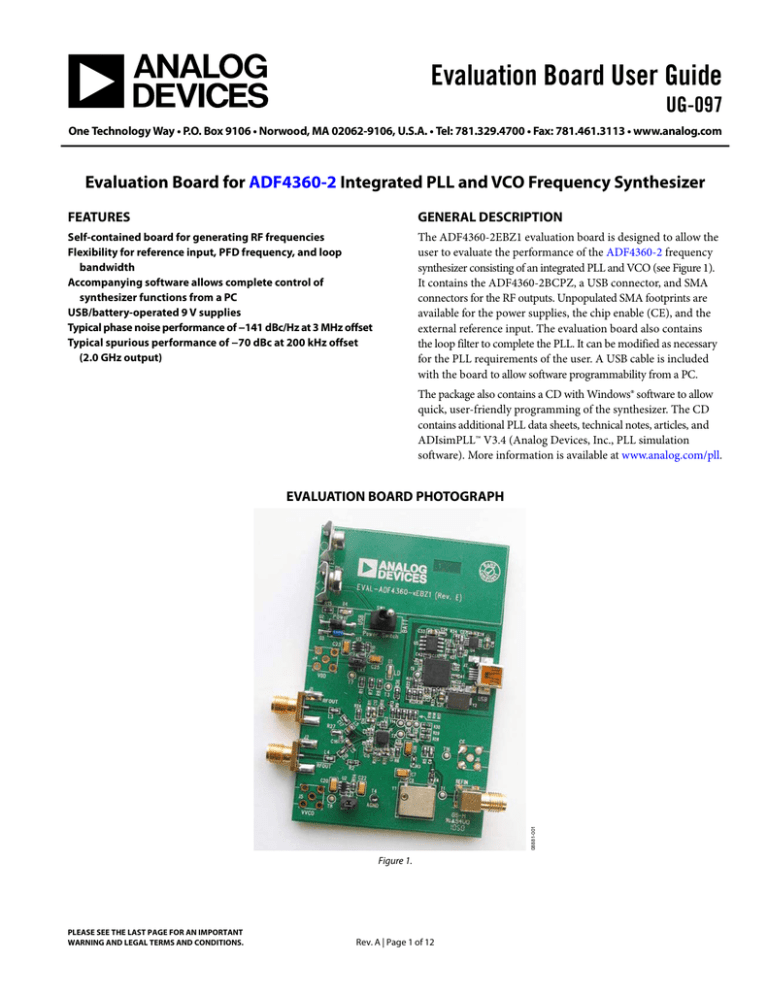
Evaluation Board User Guide UG-097 One Technology Way • P.O. Box 9106 • Norwood, MA 02062-9106, U.S.A. • Tel: 781.329.4700 • Fax: 781.461.3113 • www.analog.com Evaluation Board for ADF4360-2 Integrated PLL and VCO Frequency Synthesizer FEATURES GENERAL DESCRIPTION Self-contained board for generating RF frequencies Flexibility for reference input, PFD frequency, and loop bandwidth Accompanying software allows complete control of synthesizer functions from a PC USB/battery-operated 9 V supplies Typical phase noise performance of −141 dBc/Hz at 3 MHz offset Typical spurious performance of −70 dBc at 200 kHz offset (2.0 GHz output) The ADF4360-2EBZ1 evaluation board is designed to allow the user to evaluate the performance of the ADF4360-2 frequency synthesizer consisting of an integrated PLL and VCO (see Figure 1). It contains the ADF4360-2BCPZ, a USB connector, and SMA connectors for the RF outputs. Unpopulated SMA footprints are available for the power supplies, the chip enable (CE), and the external reference input. The evaluation board also contains the loop filter to complete the PLL. It can be modified as necessary for the PLL requirements of the user. A USB cable is included with the board to allow software programmability from a PC. The package also contains a CD with Windows® software to allow quick, user-friendly programming of the synthesizer. The CD contains additional PLL data sheets, technical notes, articles, and ADIsimPLL™ V3.4 (Analog Devices, Inc., PLL simulation software). More information is available at www.analog.com/pll. 08881-001 EVALUATION BOARD PHOTOGRAPH Figure 1. PLEASE SEE THE LAST PAGE FOR AN IMPORTANT WARNING AND LEGAL TERMS AND CONDITIONS. Rev. A | Page 1 of 12 UG-097 Evaluation Board User Guide TABLE OF CONTENTS Features .............................................................................................. 1 Windows XP OS ............................................................................4 General Description ......................................................................... 1 Windows Vista OS and Windows 7 (32-Bit) OS ..........................5 Evaluation Board Photograph ......................................................... 1 Windows 7 64-Bit OS ...................................................................5 Revision History ............................................................................... 2 Using the Evaluation Board Software .............................................6 Evaluation Board Hardware ............................................................ 3 Evaluation Board Schematic ............................................................8 RF Output Stages .......................................................................... 3 Ordering Information .................................................................... 11 Evaluation Board Software Quick Start Procedures .................... 4 Bill of Materials ........................................................................... 11 REVISION HISTORY 9/11—Rev. 0 to Rev. A Changes to Features Section and Figure 1..................................... 1 Changes to Evaluation Board Hardware Section ......................... 3 Added Evaluation Board Software Quick Start Procedures Section ................................................................................................ 4 Changes to Using the Evaluation Board Software Section.......... 6 Changes to Evaluation Board Schematic Section ......................... 8 Changes to Bill of Materials Section ............................................ 11 7/10—Revision 0: Initial Version Rev. A | Page 2 of 12 Evaluation Board User Guide UG-097 EVALUATION BOARD HARDWARE The evaluation board comes with a cable to connect it to the USB port of a PC. The silkscreen and cable diagram for the evaluation board are shown in Figure 2. The board schematics are shown in Figure 9 through Figure 11. Users may provide their own power supplies using the J4 and J5 connectors, as shown in Figure 2. Hardware power-down using the CE pin can be controlled by inserting an SMA connector into J6 and removing R12. The on-board filter is a third-order, passive, low-pass filter. The filter contains three capacitors (C13, C14, and C15) plus two resistors (R10 and R11). The footprint for R10 is located on the underside of the board. The design parameters for the loop filter are for a center frequency of 2000 MHz, a PFD frequency of 200 kHz, and a low-pass filter bandwidth of 10 kHz. To design a filter for different frequency setups, use the ADIsimPLL simulation software. RF OUTPUT STAGES 08881-002 The output stage of the board contains a tuned load for the particular frequency of operation. The particular network inserted in the board is optimized for 2000 MHz operation. This consists of a 2 nH shunt inductor, a 10 pF series capacitor, and a 2 nH series inductor. If in doubt, use a 50 Ω resistor instead of the shunt inductor, a 100 pF bypass capacitor, and a series 0 Ω resistor. It is important that the same components be placed on the RFOUTA and RFOUTB lines. In addition, it is essential that both outputs be terminated with 50 Ω loads. Otherwise, the output power is not optimum, and in some cases, the part may malfunction. Figure 2. Evaluation Board Silkscreen—Top View The board is powered from a single 9 V battery, or from the USB supply, by changing the position of Switch SW1. All components necessary for LO generation are catered for on-board. A 10 MHz TCXO from Fox Electronics provides the necessary reference input. Otherwise, an external reference signal can be connected via J3. The PLL comprises the ADF4360-2BCPZ and a passive loop filter. The VCO output from RFOUTA is available through the standard SMA Connector J1 and the complementary RFOUTB VCO output is available from J2. Rev. A | Page 3 of 12 UG-097 Evaluation Board User Guide EVALUATION BOARD SOFTWARE QUICK START PROCEDURES The control software and USB drivers for EVAL-ADF43602EBZ1 accompany the EVAL-ADF4360-2EBZ1 on a CD. To install the software, use the following steps: 3. Browse to C:\Program Files\Analog Devices\ADF4360. 4. Click Continue Anyway when asked about Windows Logo testing. 1. 2. 5. If the install was successful, the message box in Figure 4 appears. Open ADF4360_Setup.msi. The install wizard guides you through the installation process. The software and USB drivers will be installed in the default directory called C:\Program Files\Analog Devices\ADF4360. WINDOWS XP OS Figure 4. Successful Install Once you have installed the software, install the USB drivers. To do so, use the following steps: 2. Plug in a USB cable to the USB connector on the evaluation board. The Found New Hardware box appears. See Figure 3. Choose Install from a list or specified location (Advanced). 08881-003 1. 08881-004 The software requires Microsoft’s .NET Framework Version 2.0 or later to be installed on your machine. The installer automatically downloads the framework from the Microsoft website if you do not have this installed. If you do not have an Internet connection or have a slow connection on the PC, then you can install the .NET framework directly from the CD. Do this by double-clicking dotnetfx.exe. Once installed, run the ADF4360_Setup.msi again. Figure 3. New Hardware Wizard Rev. A | Page 4 of 12 Evaluation Board User Guide UG-097 WINDOWS VISTA OS AND WINDOWS 7 (32-BIT) OS 3. For Windows Vista or Windows 7 (32-bit), you need to manually install the drivers. To do so, use the following steps: Find the new unknown device (the evaluation board) in Device Manager and double-click it to open the properties. The device should be Unknown device, under Other devices (see Figure 5). 08881-007 7. 08881-005 1. 4. 5. 6. Figure 7. Successful Install Figure 5. Device Manager WINDOWS 7 64-BIT OS Click Update Driver in the properties window (see Figure 6). If you are using Windows 7 64-bit OS, it is recommended to download Windows XP Mode (a Windows XP emulator) from Microsoft to run the evaluation board software. Windows XP Mode allows the device driver package to digitally sign allowing you to use Windows 7 64-bit OS in native mode. 08881-006 2. On the Update Driver Software dialog box, choose Browse my computer for driver software. Browse to C:\Program Files\Analog Devices\ADF4360. Click OK or Next. If prompted by Windows Security, choose Install this driver software anyway. If the install was successful, the message box in Figure 7 appears. Figure 6. Unknown Device Properties Rev. A | Page 5 of 12 UG-097 Evaluation Board User Guide USING THE EVALUATION BOARD SOFTWARE The Settings section controls the charge pump current setting, the output power setting, and the multiplexer output setting. The control software for the EVAL-ADF4360-xEBZ1 accompanies the EVAL-ADF4360-xEBZ1 on a CD. To install the software, see the Evaluation Board Software Quick Start Procedures section. To run the software, click the ADF4360.exe file on the desktop or in the Start menu. The main interface window appears (see Figure 8). Confirm that Analog Devices RFG.L Eval Board connected is displayed at the top of the window. Otherwise, the software has no connection to the evaluation board. The evaluation board can be connected and disconnected while the software is running. Note that when connecting the board, it takes about 5 seconds for the status label to change. Under the File menu, the current settings can be saved to, and loaded from, a text file. Use the REF IN Frequency text box to set the correct reference frequency and the reference frequency divider. The reference TCXO on the evaluation board runs at 10 MHz. Use the Frequency Settings section to control the output frequency. The user can input the desired output frequency in the RF Output Frequency text box (in megahertz). In the Registers tab, the user can manually input the desired value to be written to the registers. In the Sweep and hop tab, the user can make the device sweep a range of frequencies, or hop between two set frequencies. In the Latches to write section, at the bottom of the window, the values to be written to each register are displayed. If the background on the text box is green, then the value displayed is different to the value actually on the device. Click Write x Latch to write that value to the device. The F2, F3, and F4 keys switch between the three tabs. F12 increases the output frequency by one channel spacing and writes it to the device. F11 decreases the output frequency by one channel spacing. Rev. A | Page 6 of 12 UG-097 08881-008 Evaluation Board User Guide Figure 8. Software Front Panel Display Rev. A | Page 7 of 12 UG-097 Evaluation Board User Guide EVALUATION BOARD SCHEMATIC 08881-009 Figure 9. EVAL-ADF4360-2EBZ1 Schematic Rev. A | Page 8 of 12 Evaluation Board User Guide UG-097 08881-010 Figure 10. EVAL-ADF4360-2EBZ1 Schematic (Continued) Rev. A | Page 9 of 12 UG-097 Evaluation Board User Guide 08881-011 Figure 11. EVAL-ADF4360-2EBZ1 Schematic (Continued) Rev. A | Page 10 of 12 Evaluation Board User Guide UG-097 ORDERING INFORMATION BILL OF MATERIALS Table 1. Reference Designator C1, C3, C5, C29, C30, C32, C37, C38, C39, C40, C41, C42, C43 C2, C4, C6, C8 C7 C9, C10, C27 C11, C12, C21, C24 C13 C14 C15 C16 C17, C19 C18, C28 C20, C23 C22, C25 C26 C31, C33 C34 C35, C36 D1 D2 D3 Part Description Capacitor, 0402, 0.1 µF, 16 V Manufacturer/Part No. Kemet C0402C104K4RAC Capacitor, 0402, 10 pF, 50 V Capacitor, Case A, 22 µF, 6.3 V Capacitor, 0603, 1 nF, 50 V Capacitor, 0402, 10 nF, 16 V Capacitor, loop filter, 0603, 1 nF, 50 V Capacitor, loop filter, 0603, 10 nF, 50 V Capacitor, loop filter, 0603, 330 pF, 50 V Multilayer ceramic capacitor, 50 V, X7R, 1 nF, ±10%, 0402 Capacitor, 0603, 10 pF, 50 V Capacitor, 0603, 1 µF, 25 V Capacitor, Case A, 1 µF, 16 V Capacitor, Case A, 4.7 µF, 10 V Capacitor, Case A, 10 µF, 6.3 V Capacitor, 0805, 10 µF, 6.3 V Capacitor, 0402, 22 pF, 50 V NPO Capacitor, 0402, 12 pF, 50 V LED, SMD red Diode, 1 A, 50 V Schottky diode, 20 V D4 J1, J2 J3 to J6 J7 L1, L2 L3, L4 L5, L6 LK1, LK2 LED, SMD red Jack SMA end launch tab Jack SMA end launch tab (not inserted) USB mini-B Ceramic chip inductor, 0402 (not inserted) Ceramic chip inductor, 2 nH, 5%, 0402 Ceramic chip inductor, 2 nH, 5%, 0402 Header, 1-row, 2-way and jumper socket black Kemet C0402C100J5GACTU AVX TAJA226K006R AVX 06035A102JAT2A Yageo (Phycomp) CC0402ZRY5V7BB103 Phycomp 2238 861 15102 AVX 08055C103KAT2A Phycomp 2238 861 15331 Murata GRM155R71H102KA01D AVX 06035A100JAT2A Taiyo Yuden TMK107BJ105KA-T AVX TAJA105K016R AVX TPSA475K010R1400 Kemet T491A106M016AT Murata GRM21BR71A106KE51L Kemet C0402C220J5GACTU Kemet C0402C120J5GACTU Avago HSMS-C170 Multicomp 1N4001 Micro Commercial Components, Inc., SD103C-TP Avago HSMS-C170 Johnson Components 142-0701-851 P1 R1 to R4, R13, R22 to R24, R27, R36, R38 R5 R6, R15 R7, R8, R12, R28, R29, R30 R9 R10 R11 R14, R16 R17 to R19 R20, R21 R25, R26 R31, R32 R34 Battery clip, PCB mounting Resistor, 0603, 0 Ω Coilcraft 0402CS-2N0X_LU Coilcraft 0402CS-2N0X_LU Harwin Plc M20-9990245 and Harwin Plc M7567-05 Keystone Electronics Corp. 593+594 Multicomp MC 0.063W 0603 0R Resistor, 0603, 51 Ω Resistor, 0603, 4.7 kΩ Resistor, 0603, 10 kΩ Multicomp MC 0.063W 0603 1% 51R Multicomp MC 0.063W 0603 1% 4K7 Multicomp MC 0.063W 0603 1% 10K Resistor, 0603, 100 Ω Resistor, loop filter, 0805, 8.2 kΩ Resistor, loop filter, 0805, 4.3 kΩ Resistor, 0603, 330 kΩ Resistor, 0603, 330 Ω Resistor, 0603, 2.2 kΩ Resistor, 0603, 470 Ω Resistor, 0603, 100 kΩ Resistor, 0603, 140 kΩ Multicomp MC 0.063W 0603 1% 100R Multicomp MC 0.1W 0805 1% 8K2 Multicomp MC 0.1W 0805 1% 4K3 Multicomp MC 0.063W 0603 1% 330K Multicomp MC 0.063W 0603 1% 330R Multicomp MC 0.063W 0603 1% 2K2 Multicomp MC 0.063W 0603 1% 470R Multicomp MC 0.063W 0603 1% 100K Multicomp MC 0.063W 0603 1% 140K Rev. A | Page 11 of 12 Molex 56579-0576 UG-097 Reference Designator R35 SW1 T1 to T8, T13 to T16 T9 to T12 U1 U2 U3 U4 U5 U6 Y1 Evaluation Board User Guide Part Description Resistor, 0603, 78.7 kΩ Switch, PCB SPDT Terminal, PCB, red, PK100 Test point (not inserted) Integrated integer-N synthesizer High accuracy low dropout linear 5 V regulator High accuracy low dropout linear 3 V regulator ADP3334 Adjustable LDO regulator IC Serial EEPROM 8-SOIC USB Microcontroller 10 MHz TCXO (FOX801) Manufacturer/Part No. Multicomp MC 0.063W 0603 1% 78K7 APEM TL36P0050 Vero Technologies, Ltd. 20-313137 Analog Devices, ADF4360-2BCPZ Analog Devices, ADP3300ARTZ-3 Analog Devices, ADP3300ARTZ-3 Analog Devices, ADP3334ARMZ Microchip 24LC64-ISN Cypress CY7C68013A-56LFXC Fox Electronics FOX801-BELF ESD Caution ESD (electrostatic discharge) sensitive device. Charged devices and circuit boards can discharge without detection. Although this product features patented or proprietary protection circuitry, damage may occur on devices subjected to high energy ESD. Therefore, proper ESD precautions should be taken to avoid performance degradation or loss of functionality. Legal Terms and Conditions By using the evaluation board discussed herein (together with any tools, components documentation or support materials, the “Evaluation Board”), you are agreeing to be bound by the terms and conditions set forth below (“Agreement”) unless you have purchased the Evaluation Board, in which case the Analog Devices Standard Terms and Conditions of Sale shall govern. Do not use the Evaluation Board until you have read and agreed to the Agreement. Your use of the Evaluation Board shall signify your acceptance of the Agreement. This Agreement is made by and between you (“Customer”) and Analog Devices, Inc. (“ADI”), with its principal place of business at One Technology Way, Norwood, MA 02062, USA. Subject to the terms and conditions of the Agreement, ADI hereby grants to Customer a free, limited, personal, temporary, non-exclusive, non-sublicensable, non-transferable license to use the Evaluation Board FOR EVALUATION PURPOSES ONLY. Customer understands and agrees that the Evaluation Board is provided for the sole and exclusive purpose referenced above, and agrees not to use the Evaluation Board for any other purpose. Furthermore, the license granted is expressly made subject to the following additional limitations: Customer shall not (i) rent, lease, display, sell, transfer, assign, sublicense, or distribute the Evaluation Board; and (ii) permit any Third Party to access the Evaluation Board. As used herein, the term “Third Party” includes any entity other than ADI, Customer, their employees, affiliates and in-house consultants. The Evaluation Board is NOT sold to Customer; all rights not expressly granted herein, including ownership of the Evaluation Board, are reserved by ADI. CONFIDENTIALITY. This Agreement and the Evaluation Board shall all be considered the confidential and proprietary information of ADI. Customer may not disclose or transfer any portion of the Evaluation Board to any other party for any reason. Upon discontinuation of use of the Evaluation Board or termination of this Agreement, Customer agrees to promptly return the Evaluation Board to ADI. ADDITIONAL RESTRICTIONS. Customer may not disassemble, decompile or reverse engineer chips on the Evaluation Board. Customer shall inform ADI of any occurred damages or any modifications or alterations it makes to the Evaluation Board, including but not limited to soldering or any other activity that affects the material content of the Evaluation Board. Modifications to the Evaluation Board must comply with applicable law, including but not limited to the RoHS Directive. TERMINATION. ADI may terminate this Agreement at any time upon giving written notice to Customer. Customer agrees to return to ADI the Evaluation Board at that time. LIMITATION OF LIABILITY. THE EVALUATION BOARD PROVIDED HEREUNDER IS PROVIDED “AS IS” AND ADI MAKES NO WARRANTIES OR REPRESENTATIONS OF ANY KIND WITH RESPECT TO IT. ADI SPECIFICALLY DISCLAIMS ANY REPRESENTATIONS, ENDORSEMENTS, GUARANTEES, OR WARRANTIES, EXPRESS OR IMPLIED, RELATED TO THE EVALUATION BOARD INCLUDING, BUT NOT LIMITED TO, THE IMPLIED WARRANTY OF MERCHANTABILITY, TITLE, FITNESS FOR A PARTICULAR PURPOSE OR NONINFRINGEMENT OF INTELLECTUAL PROPERTY RIGHTS. IN NO EVENT WILL ADI AND ITS LICENSORS BE LIABLE FOR ANY INCIDENTAL, SPECIAL, INDIRECT, OR CONSEQUENTIAL DAMAGES RESULTING FROM CUSTOMER’S POSSESSION OR USE OF THE EVALUATION BOARD, INCLUDING BUT NOT LIMITED TO LOST PROFITS, DELAY COSTS, LABOR COSTS OR LOSS OF GOODWILL. ADI’S TOTAL LIABILITY FROM ANY AND ALL CAUSES SHALL BE LIMITED TO THE AMOUNT OF ONE HUNDRED US DOLLARS ($100.00). EXPORT. Customer agrees that it will not directly or indirectly export the Evaluation Board to another country, and that it will comply with all applicable United States federal laws and regulations relating to exports. GOVERNING LAW. This Agreement shall be governed by and construed in accordance with the substantive laws of the Commonwealth of Massachusetts (excluding conflict of law rules). Any legal action regarding this Agreement will be heard in the state or federal courts having jurisdiction in Suffolk County, Massachusetts, and Customer hereby submits to the personal jurisdiction and venue of such courts. The United Nations Convention on Contracts for the International Sale of Goods shall not apply to this Agreement and is expressly disclaimed. ©2010–2011 Analog Devices, Inc. All rights reserved. Trademarks and registered trademarks are the property of their respective owners. UG08881-0-9/11(A) Rev. A | Page 12 of 12
